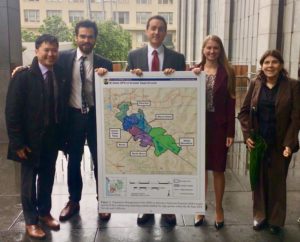Environmental Law Clinic Scores Big Win for the Bi-State Sage Grouse
In a lawsuit brought by the Environmental Law Clinic, a federal court ruled that the U.S. Fish and Wildlife Service wrongly denied the bi-state sage grouse protection as a threatened or endangered species.
The bi-state sage grouse are large, striking birds known for their distinctive mating dance.
Over the last 150 years, the subspecies has lost over half of its population, half of its habitat, and two-thirds of its breeding grounds. The already-fragmented sagebrush habitat is further threatened by grazing, wildfires, climate change, and invasive plants that eliminate critical cover. Today, the bi-state sage grouse is limited to only six small, isolated subpopulations in Eastern California and Western Nevada, four of which are at risk of disappearing altogether over the next few decades.
Faced with these dire conditions, the Service concluded in 2013 that populations had declined to such an extent that the species should be listed as threatened under the Endangered Species Act. But two years later, in an abrupt about-face, the government withdrew the proposal to list the bi-state sage grouse. ELC, on behalf of clients Desert Survivors, Center for Biological Diversity, WildEarth Guardians, and Western Watersheds Project, sued the federal government challenging the Service’s withdrawal decision.
In an 85-page opinion, the U.S. District Chief Magistrate ruled that the agency relied on a questionable study and improperly ignored its own best science when it changed course in 2015 and decided not to offer Endangered Species Act protections to the bi-state sage grouse. While the judge noted that courts must defer to an agency’s evaluation of the scientific evidence, the agency “must offer SOME rational basis for its conclusions that future conservation efforts will be effective enough to improve the status of the bi-state (grouse) and therefore warrant withdrawal of the proposed listing.” That rationale basis was lacking here, with the agency relying on ad hoc voluntary conservation efforts that it failed to show would effectively protect the species.
In addition to overturning the Service’s decision to withdraw the bird from listing consideration, the court held that a major U.S. Fish and Wildlife Service national policy interpreting the Endangered Species Act is unlawful. While the Endangered Species Act makes clear that a species need only be threatened throughout a significant portion of its range to be listed, the Service’s policy has in practice been requiring that a species be threatened throughout all of its range to be eligible for listing. Clinic students contended that this conflation of “significant portion of its range” and “all of its range” effectively raises the bar beyond what the Endangered Species Act intended for showing that a species is threatened or endangered, thereby furthering imperiling at-risk species. The court’s holding on this policy could have national implications, leading to greater protection of current and future species.

The sage grouse victory was made possible by the tireless efforts of many students over the past few years and the passionate leadership of Clinic Director Deborah Sivas and Clinical Supervising Attorney Isaac Cheng. Clinic students Michael Komorowski (JD ’18) and Ben DeGolia (JD/MS ’19) presented oral argument in federal district court last month. Kirsten Dedrickson (JD’ 18) and Faaris (Fares) Akremi (JD ’18) also worked on the briefs and argued prior motions, and Michelle Wu (JD/MS ’17) and Mary Rock (JD/MS ’17) drafted the initial complaint.
Read more news about the Court’s decision here. Additional hearings will determine the next steps in protecting this unusual species.
Note: Sage Grouse Image courtesy of Sierra Wave
